Another photographer whose work has explored the notion of politicised landscapes is John Darwell in his book, Dark Days (Dewi Lewis Publishing, 2007), which documents the 2001 UK Foot and Mouth Epidemic in the Lake District.
Here Darwell explains the work:
“This work produced around my home on the north side of the English Lake District looks at the Foot and Mouth epidemic that swept through the UK in 2001 and became one of the most devastating and significant events to affect the British countryside within living memory, the aftershock of which will continue to shape the future of the countryside for decades to come. The images look to all affected areas from the Lake District fells closed to walkers to the measures farmers went to in order to keep people away from their farms for fear of infection, to the destruction of millions of farm animals and onto the now notorious pyres. The work then continues by recording the extraordinary efforts undertaken by farmers to eradicate the virus from their buildings; and finally the third part of the work looks at the aftermath of the disease and the gradual reopening of the countryside whilst asking questions about the future of the agricultural economy as more and more farms were put up for sale.”
And here are a selection of the photographs:
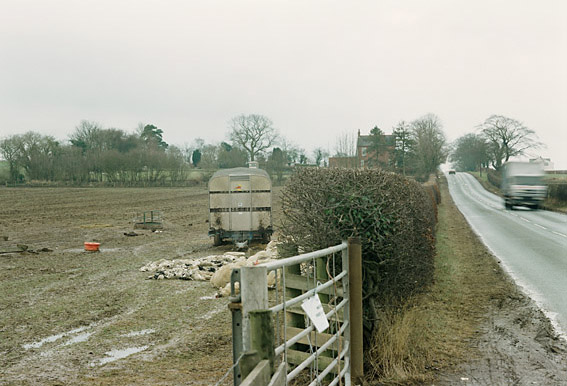
Dead lambs by roadside © John Darwell, 2001
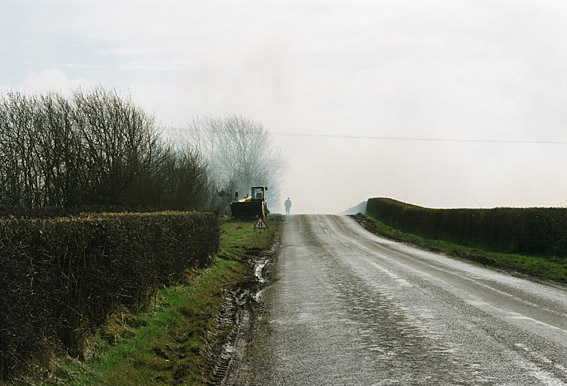
Roadside pyre © John Darwell, 2001
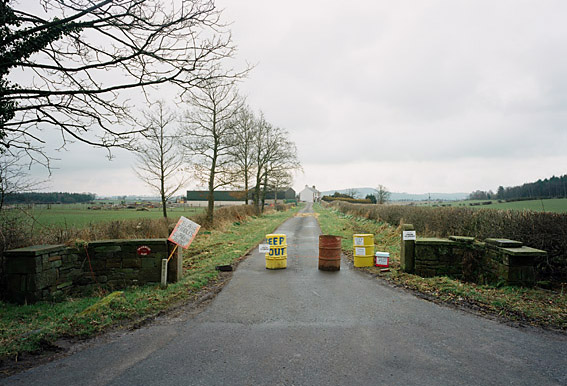
Barricaded farm entrance, Southwaite © John Darwell, 2001
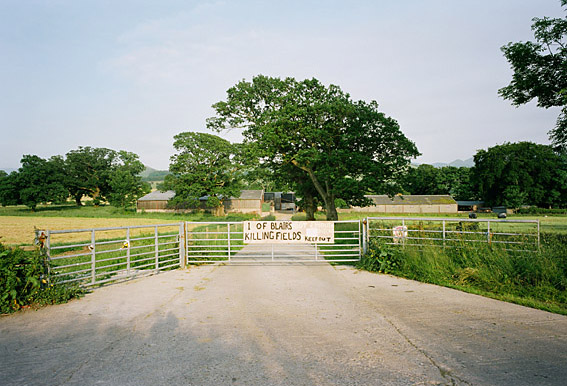
Farm gate protest sign reads ‘1 of Blairs Killing Fields’, Lorton © John Darwell, 2001
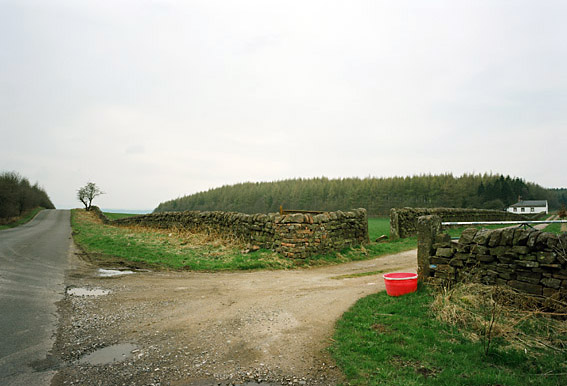
Disinfection bowl, Near Carlisle © John Darwell, 2001
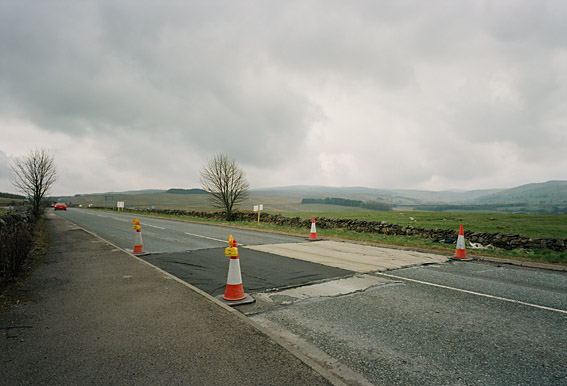
Disinfection mat on the A6, Shap © John Darwell, 2001
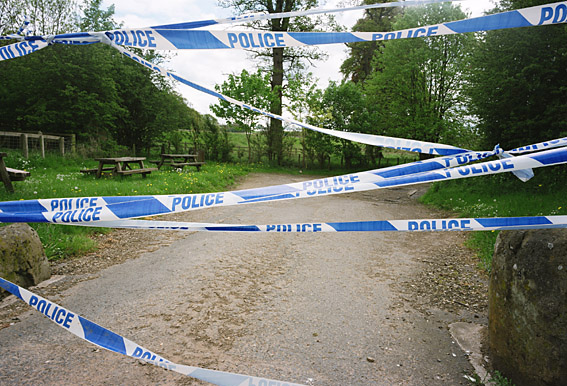
Closed picnic site on M6, Carlisle © John Darwell, 2001
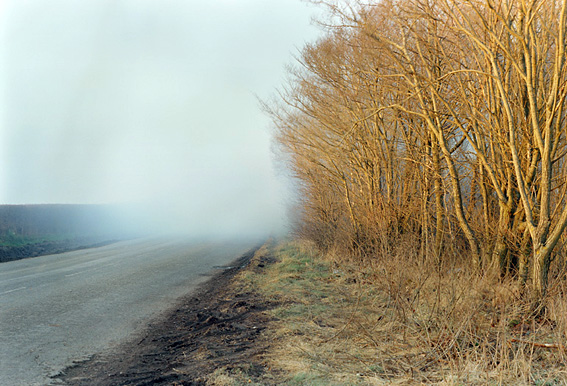
Smoke on road, Welton © John Darwell, 2001
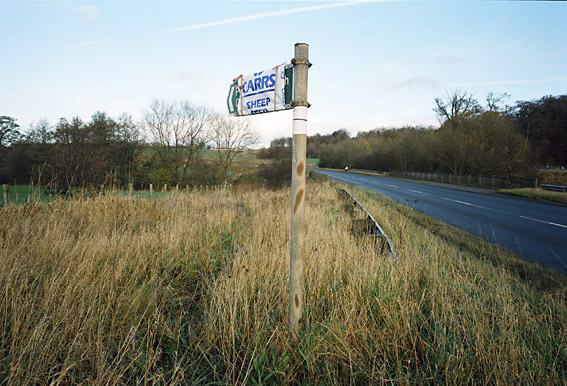
Footpath sign closed, Carlisle © John Darwell, 2001
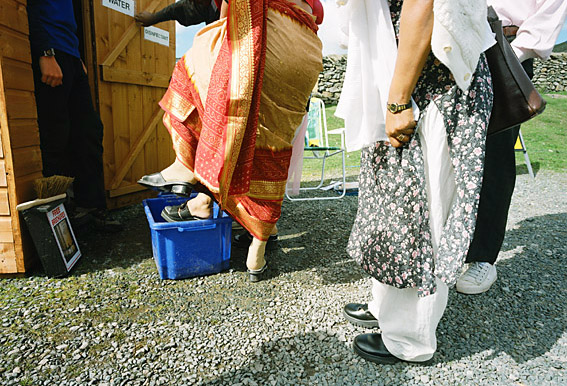
Bangladeshi schoolteachers disinfecting their feet © John Darwell, 2001
Explaining this last picture Darwell comments “this photograph was taken on the first day the fells were open after the lifting of some the access restrictions. I went up Kirkstone Pass to see what was happening. There were dozens of people prepared to go through disinfection to get onto the fells, mostly runners and keen walkers. Whilst I was watching a coach arrived and dozens of people got off, the ladies in saris and sandals the men in linen suits. They had just arrived from Bangladesh and were on their way to Ambleside to begin teaching at the college there. The coach driver being either a comedian or not quite on the ball suggested a nice walk on the hills to get a sense of the place, hence their first experience of Cumbria was having to place their feet in buckets of disinfectant before walking up a soggy hillside. I had a long chat with some of them and after some initial bemusement most seemed to find it quite funny and an experience to take away with them.”
You can see more images from Dark Days on Darwell’s website here.
A book of Dark Days containing 150 colour images plus text pieces by Liz Wells, Professor Roger Breeze, U.S. government advisor on animal epidemics and viral warfare and Alison Nordstrom, Curator of Photographs, George Eastman House, was published in March 2007 (Dewi Lewis Publishing). It is one of the most complete body of images produced during this period and stands as a testament to those ordinary people caught up in extraordinary events (and political incompetence!). It is a work that asks a number of searching questions, either explicitly or implicitly, about the future direction of food production and of the countryside we wish to visit.
Posted in LANDSCAPE, OTHER STUDIES | Comments Off on DARK DAYS
Following on from Friday’s post Contested Countryside, Cumbria-based photographer Stuart Parker got in touch regarding a project he worked on in response to the trial of Mohammed Hamid. Here he explains the reasons behind ‘Tomorrow We Enter Paradise’ along with a few of the photographs from the project.
“As a photographer Iiving in Cumbria I have an interest in social issues in a landscape context, particularly in the Lake District. The idea for this project stemmed from encountering a group of young Asian men on an early morning walk near Buttermere. It later transpired in the news that so called ‘Jihad training camps’ were being monitored in the Lake District by MI5, which reminded me of the group that I had seen.
I decided to explore the places at which the camps had allegedly been held including Wasdale, Buttermere, Grizedale Forest and the Langdale Valley, the latter being where the MI5 surveillance photographs were taken. The result was a series of photographs drawing on actual and metaphorical links between the Lake District, London and Afghanistan. ”
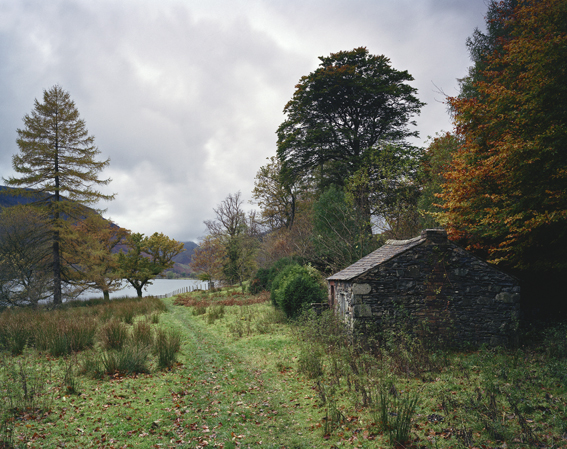
Buttermere © Stuart Parker
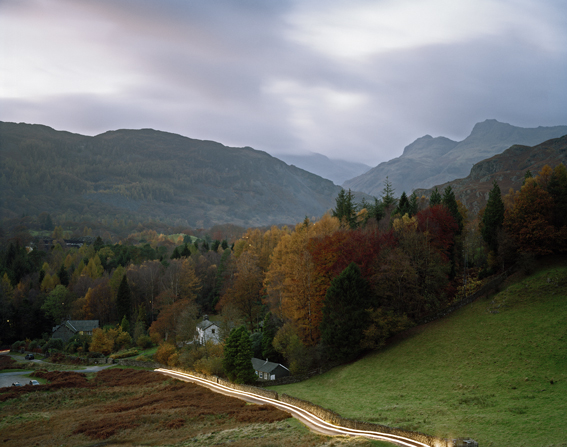
Elterwater © Stuart Parker
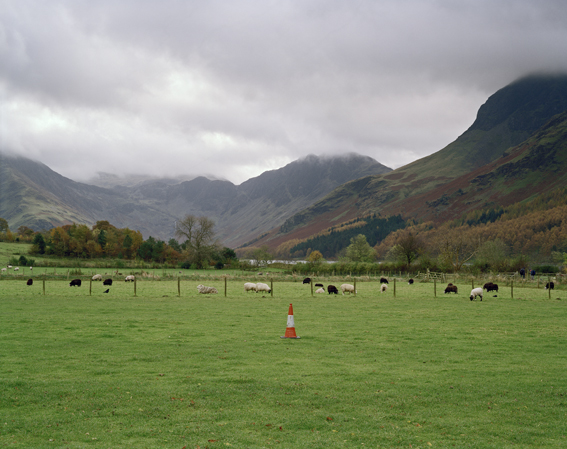
Buttermere Cone © Stuart Parker

Campfire © Stuart Parker
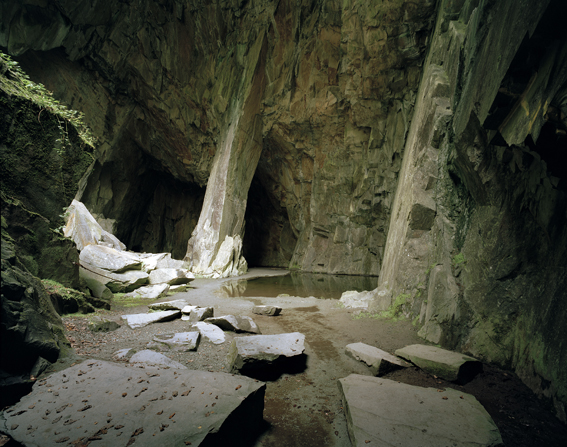
Langdale © Stuart Parker
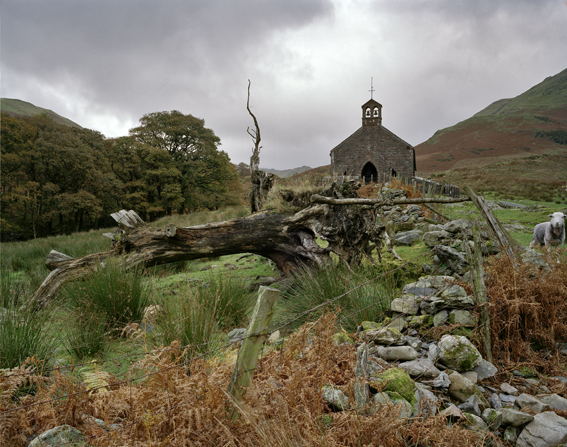
Buttermere Church © Stuart Parker
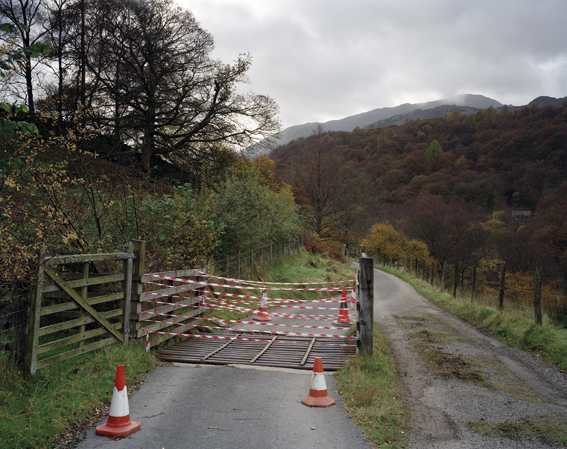
Little Langdale © Stuart Parker
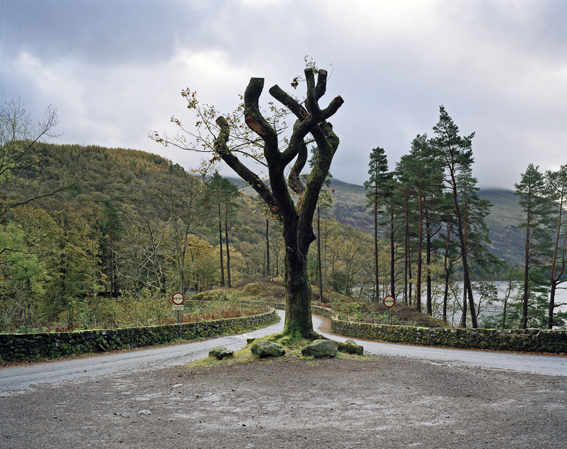
Limbs © Stuart Parker
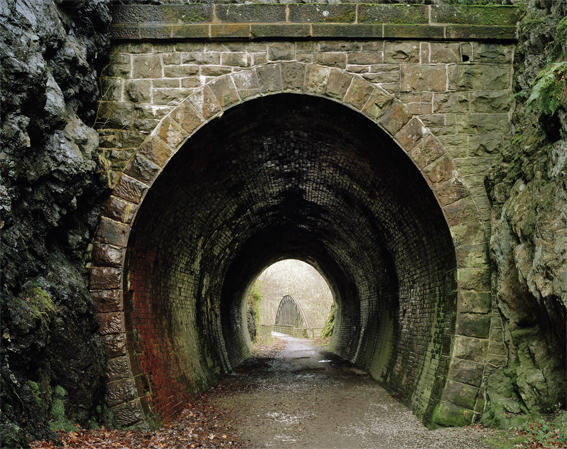
Tunnel © Stuart Parker
Posted in LANDSCAPE, OTHER STUDIES | Comments Off on TOMORROW WE ENTER PARADISE
I notice that Jem Southam has an exhibition currently showing at The Lowry until the 22nd March 2009. Clouds Descending is the result of a two year commission where Southam made photographs along the Cumbrian coastline, recording the industrial landscape and harbour towns, which Lowry loved so much.
Southam will be giving an evening lecture at The Lowry on February 6th. There is also the opportunity to take part in an all-day Masterclass with him on Saturday 7th February – full application details are available from redeyesubmissions@googlemail.com
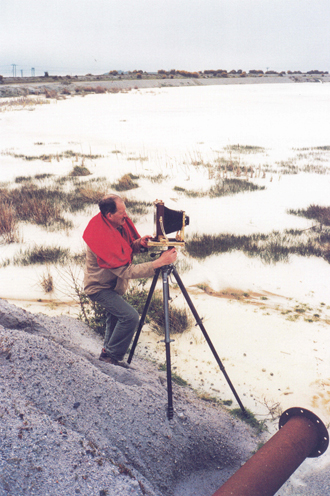
Southam has been a key figure in British photography for over twenty-five years. Working exclusively in the landscape genre, his prevailing thematic concerns are the changes, large and small, occurring within the British countryside. His photographs are the result of patient observation and contemplation over long periods of time. Often producing series, Southam layers and juxtaposes images that not only reveal cycles of nature, but the interactions of humans with their environment. He has said that he proposes “histories,†both social and natural.
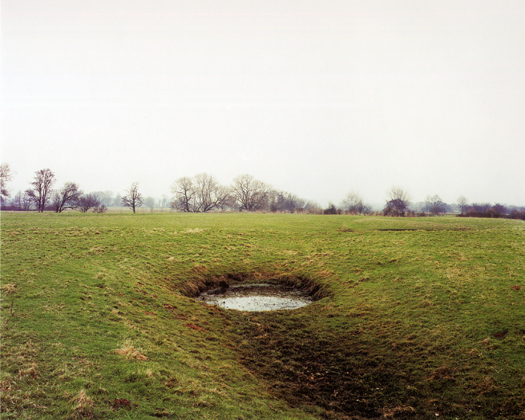
Brampford Speke, 1998 from the series Dew Ponds © Jem Southam
As David Evan’s writes in Source magazine, “For his epic theme, Southam adopts appropriate, time-consuming working methods. There is extensive preparatory research, including the study of weather forecasts. There is walking and waiting, frequently on difficult terrain. Bulky equipment is often being carried around, especially a Wista, a modern Japanese version of a Victorian plate camera. Southam only photographs on still grey days, sometimes producing just a few images in a year. The end results are crafted objects, recalling the work of 19th Century pioneers like Carleton Watkins who took along a wagon laboratory pulled by a dozen mules… Southam’s achievement is to create work informed by past and present that has conviction… [He is] the photographer of the slow rhythms of social time and the even slower rhythms of physical geography.â€
To find out more about Southam’s work, read an interview in SeeSaw Magazine here and watch a slideshow of his photographs here.
Southam is represented by Robert Mann Gallery and Charles Isaacs.
Posted in INSPIRATION, LANDSCAPE, OTHER STUDIES | 1 Comment »
Just before Christmas I attended a talk by Ingrid Pollard at Tate Britain as part of their Conversation Pieces series. It got me thing about my previous post talking about landscapes as contested places and I thought it would be interesting to touch upon the visual relationship between rural England, notions of Englishness and ethnicity.
Pollard first came to public attention in 1987 with Pastoral Interlude, a series of photographs about Black people’s experience of the English countryside, particularly the Lake District. Steeped in the heritage of Wordsworth and the Romantic poets, her photographs explore the beauty of the English landscape and coastline, alongside the memories hidden within England’s history and its relationship to Africa and the Caribbean. Her interest in the layers of history is echoed in her use of 19th century photographic techniques.
As a Black woman, Pollard articulates in her Pastoral Interlude and Wordsworth Heritage series several levels of alienation and otherness. The landscape of the Lake District, which she sees as epitomizing the ‘authentic’ British countryside, confirms the status of the Black woman as an outsider. For instance, in Pastoral Interlude, Pollard captions a photograph of a lone black female figure in the landscape,
“…it’s as if the Black experience is only lived within an urban environment. I though I liked the Lake District where I wandered lonely as a Black face in a sea of white. A visit to the countryside is always accompanied by a feeling of unease, dread….â€
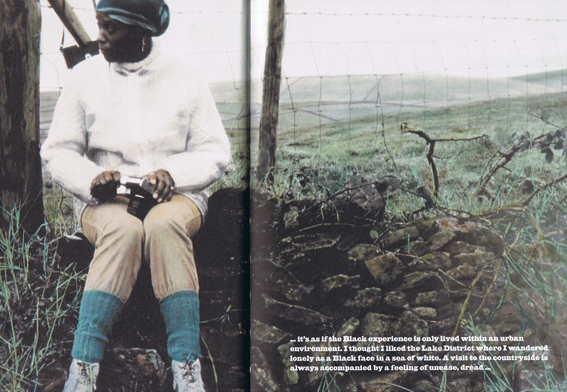
© Ingrid Pollard
The caption indicates what she takes to be the oppressive homogeneity of visitors to the region. Writing about Pastoral Interlude in her book Postcards Home (Chris Boot Ltd, 2004) Pollard says “There was an unconscious selection of the lone figure within the landscape. It became a way of working. The stylized posed figures, the use of historical details about a particular place. Nothing about the scene is really ‘natural’. It’s as manufactured and deliberate as the assumptions and stereotypes about Black people.â€
Pollard’s use of surprising, sometimes shocking captions subvert her images which otherwise show someone, who at first glance, looks like they seem to be enjoying themselves in the countryside and appear to be ‘at home’. For instance, another image of herself in the Lake District she captions
“…Searching for sea shells, waves lap my Wellington boots, carrying lost souls of brothers & sisters released over the ship side…â€
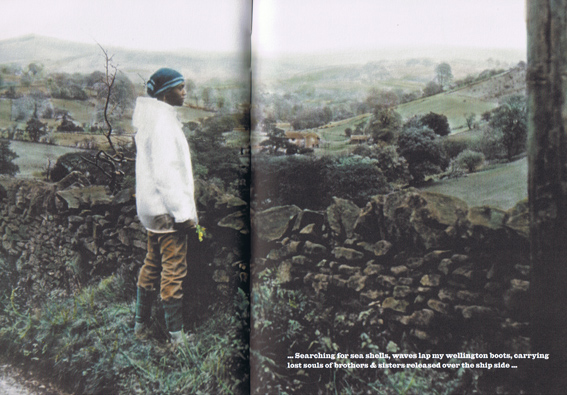
© Ingrid Pollard
As John Taylor writes in his book A Dream of England, “despite the commodification of the countryside as a haunt for well-equipped ramblers, following in the footsteps of the Romantics, for Pollard the landscape is disenchanting: the spell it casts as a commodity seeks to discount her as a customer. Her landscapes recall with irony the tradition of eighteenth century British landscape painting, which sought to establish the countryside as the natural domain of the British middle classes.â€
Twenty years after her Pastoral Interlude work was made, I wonder whether Pollard would still find the English countryside as insular and racist as she did then?
Another photographer, whose work has challenged our stereotypes and conventional readings of English rural landscapes would be John Kippin. Kippin’s work pays allegiance to the conventions and traditions of pictorial landscape whilst foregrounding issues within contemporary culture and politics. Note particularly his photograph ‘Prayer Meeting, Windemere’ taken from a body of work called Nostalgia for the Future.
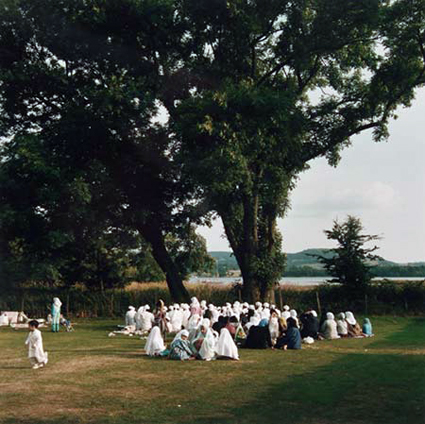
© John Kippin
Describing the scene in Creative Camera (quoted from A Dream of England), Paul Wombell writes that the party are “probably from Lancashire and came to work in the mills, and now they are tourists in this heritage England. It turns the idea of British landscape upside down; who goes there, what meanings can people get†(1992). As Taylor notes “although there is a spiritual tradition to English landscape, prayers in this fashion are quite unconnected to the pantheism or Romanticism which is usually associated with it.â€
This projection of a dominant culture in the countryside can be seen when we look at the preponderance of white, middle-class, middle-aged members of the National Trust (see this article in The Independent).
It was also recently highlighted in a study by the Commission for Racial Equality (2004), which showed that although ethnic minorities make up 8% of the UK population they represented just 1% of visitors to the countryside. The then chairman of the Commission, Trevor Phillips, suggested that a form of “passive apartheid” existed in the British countryside. His comments certainly sparked quite a debate. However, it was interesting to see how many ethnic minorities disagreed with his analysis (see replies posted on the BBC News Online here) and actually felt quite at home in the countryside.
This summer there was an article in The Guardian where four journalists described their memories of holidays in the UK. British born writer Maya Jaggi described her experiences of childhood holidays in the Lake District in the 1970s.
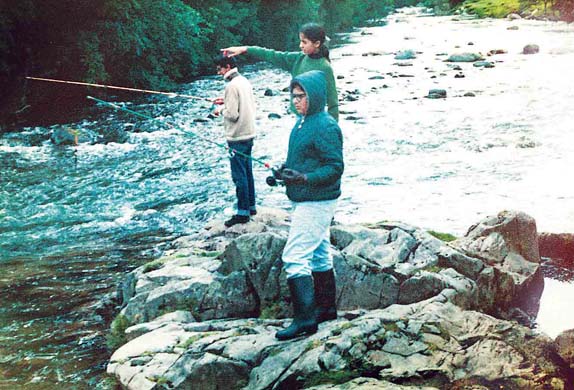
Maya Jaggi, Lake District
“The ingredients of the ideal holiday were fixed for me as a child on a trip to Windermere. After a day on the lake, messing about in a rowing boat with my family, my aunt Madhur gave me a masterclass in boning fish.†She goes on to say “My parents had taken to borrowing a friend’s cottage in the village of Ulpha near Coniston Water. My mother (Madhur’s eldest sister) was head of English in a London school, and was drawn to the Lake poet associations. She would marshal my two older brothers and me to Dove Cottage and Rydal Mount, pointing out the spot where the Ullswater daffodils sprouted. My brothers learned to fish for brown trout in the River Duddon, the inspiration for 34 Wordsworth sonnets (I was keener then on Swallows and Amazons). The riverbanks near Ulpha bridge are now a popular site for picnickers, but we had them much to ourselves.â€
Jaggi makes no reference to her or her family feeling marginalised in the landscape. They seem very much at home. In fact, she goes on to make a connection between the landscape of the Lake District and that of her father’s birthplace of the Punjab-
“For my displaced, cash-strapped parents the Lake District may have been a landscape in which to recreate for us aspects of their own childhoods. My father, whose family lost land in Punjab during Partition, would roll up his trousers and wade gamely into the becks, much to my adolescent embarrassment, while packed lunches on the fells could conceivably stand in for the lavish picnics at Himalayan hill stations that were a mythic part of my mother’s Old Delhi family. After the sisters studied at Delhi University (where my parents met), my mother left for London on her honeymoon, while Madhur, after Rada, settled in Greenwich Village. The English Lakes became a place where a family dispersed across three continents could reassemble.â€
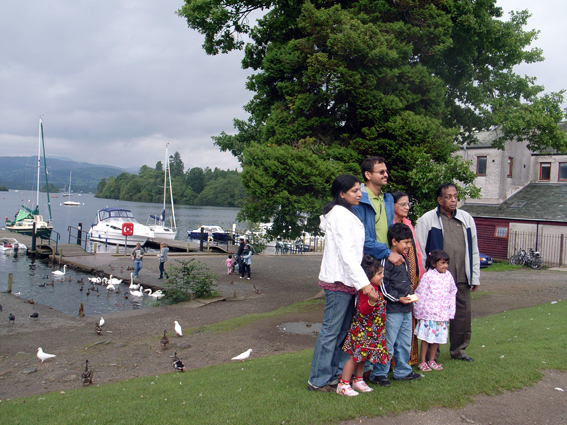
Family pose for a photograph, Bowness-on-Windermere, Lake District © Simon Roberts
In relation to my own journey around England for this project, while I found that much of rural areas in the West Country and Northumbria to be very white, in the Peak District, Yorkshire Dales, North Yorkshire Moors and Lake District I was surprised to witness relatively large numbers of ethnic minorities engaging with the countryside (as Wombell alluded to, this would make sense given the proximity of these rural retreats to large towns and cities with substantial ethnic minority populations, like Burnley, Bradford, Leeds and Blackburn), and seemingly not alienated by the environment.
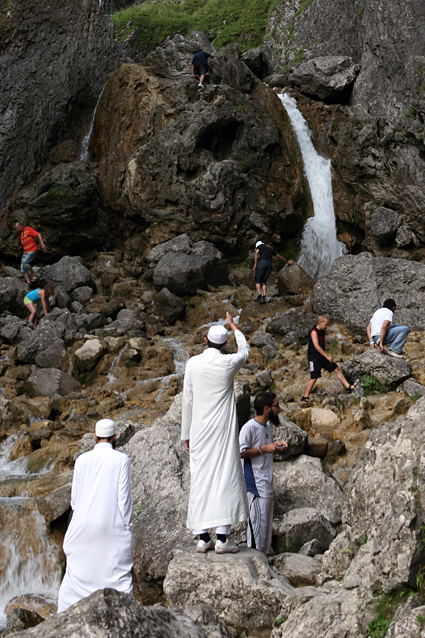
Climbing the waterfall at Gordale Scar, North Yorkshire © Simon Roberts
Take for example my photograph below of rock climbers on Stanage Edge in the Peak District. In the foreground a Muslim couple wearing distinct grey robes walk on a footpath through the landscape. Our tendency to ‘read’ this view in terms of traditional English activities is hard to resist and the couple therefore seem to be ‘out of place’. On speaking to them I learned that they were from Leicester on a weeks walking holiday, staying at a B&B in the nearby village of Hathersage. They spoke of feeling completely at ease in the area and described how they often spent their holidays exploring the English countryside.
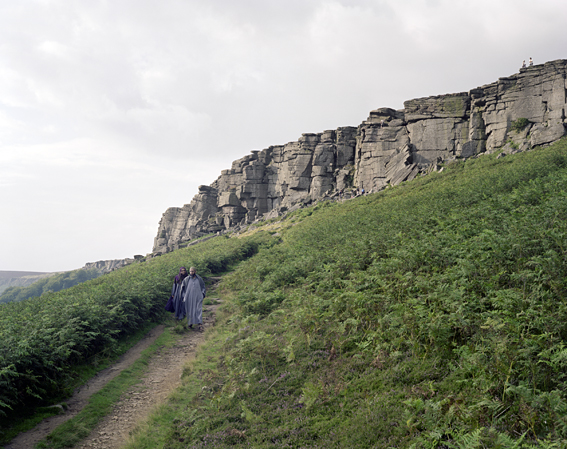
Stanage Edge, Peak District © Simon Roberts
One organization that is trying to engage more ethnic minority groups with rural England is the Mosaic Partnership. Mosaic is an organization forging links between black and minority ethnic community groups across England and Wales with four National Park Authorities (the Peak District, Yorkshire Dales, Brecon Beacons & North York Moors), the Youth Hostels Association (YHA), and the Campaign for National Parks (CNP; formerly the Council for National Parks). They are attempting to promote National Parks as part of our shared cultural heritage, as well as places offering opportunities for physical recreation and spiritual renewal.
You can read accounts written by several ethnic groups who have taken tours in National Parks on Mosaic’s website here.
It’s worth mentioning that there is also a political dimension to landscapes of rural England. Take for example the reporting and politicised nature of the foot-and-mouth outbreak or the trail of Mohammed Hamid, who was jailed in February 2008 for organising al-Qaida style training camps across Britain (read article in The Guardian here). In relation to ethnicity, this latter event is of interest.

Photographs taken by two surveillance officers from Scotland Yard (above) showed Hamid, and several other Muslim men in a group of 23 others, on exercises at a farm in the Elterwater area of the Lake District. In the trial Hamid claimed these were bonding sessions to bring together Muslim men who felt vulnerable after 9/11. But police said he was trying to recruit and train young men for violent jihad. Hamid organised two more camps in the Lakes. The last on 17 August 2004 included 21/7 ringleader Muktar Ibrahim. MI5 officers covertly filmed this gathering. Hamid later organized excercises in secluded sites in the New Forest and paintballing centres in south-east England.
The widespread reporting and publication of these photographs provoked headlines around the world linking rural England with terrorism-
“Training camps for terrorists in UK parks†The Guardian, 14th August 2006
“Holiday trip, or a ‘bomber’ training camp?†Daily Telegraph, 19th January 2007
“Al Qaeda terrorist who took part in Lake District training camp sentenced to six years in prison†Daily Mail, 22nd November 2007
“Network of terrorist camps in rural England – Convictions of 7 militants revealed terror activities in idyllic rural settings†MSNBC, 26th February 2008
“Trial exposes network of UK terror camps” Zee News, 27th February 2008
to be continued….
Posted in OTHER STUDIES, REPRESENTATION, RESEARCH | 5 Comments »
Martin Parr got in touch after my post commenting on photographs from his British cities project (Underwhelmed by Parr), which published in The Guardian’s Weekend Magazine. Martin was kind enough to send me a couple of samples of the individual supplements, so I thought I’d post up some layouts along with quotes from him talking about the work. (Quotes were taken from an interview Martin did with David Land in the RPS Journal, October 2008 issue, and on the Martin Parr We Love U/Discuss? Flickr page).
As readers will know from my post, I was quite critical about the photographs that featured in The Guardian. Martin replied-
“Do remember Simon has only seen the spread in the Weekend magazine, which I did not think was the best edit. Had this been the only thing someone had seen I would have sympathy with his comments. I did relinquish control for the Weekend spread, but was given the chance to sign off and indeed steer the individual supplements in the direction I wanted. Any criticism should be based on the original edit, that I signed off. There have been many comments on this project, some negative and some critical. However if you look at all 160 pages of my depiction of contemporary Britain, it does make sense.â€
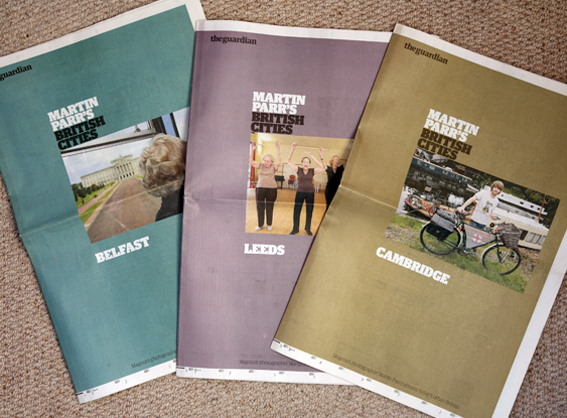
“The motivation for the Guardian was very simple, they wanted to find a project that helped to boost circulation (or at least on the day of publication) in their key cities for readership (London being the exception). This is why Cambridge had a supplement, and Birmingham did not. They also wanted to demonstrate that they are interested in the key regional cities in the UK.”
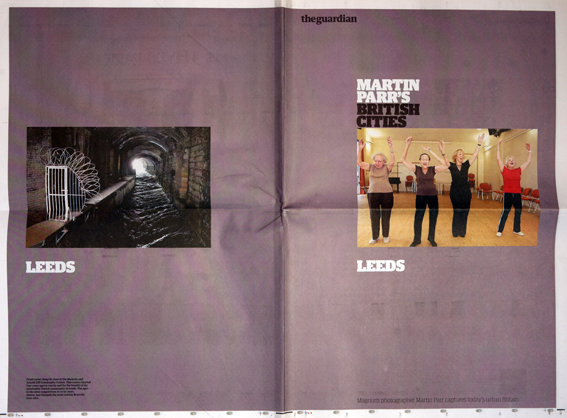
The cities and publication dates for the supplements were-
Cardiff (July 26th 2008)
Bristol (Aug 2nd 2008)
Edinburgh (Aug 23rd 2008)
Belfast (Sept 27th 2008)
Newcastle and Cambridge (Oct 25th 2008)
Leeds (Nov 22nd2008)
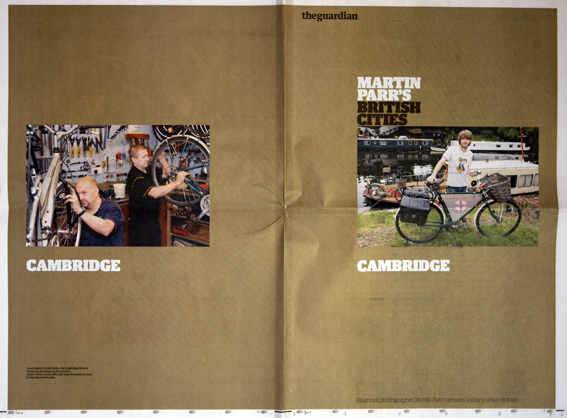
“That said I believe the boldness of this project has to be applauded as they have shown real commitment to photography by commissioning this. All the images from this project will potentially go towards a new book I am planning about the UK in a few years time. The Guardian were keen to make a book, and I steered them away from this, as I thought the idea of a box of the original newspaper supplements was a lot better. I still do, as this project has an identity that is unique.â€
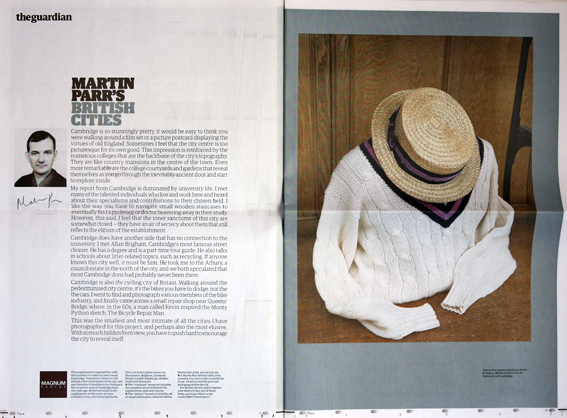
“It’s been fantastic doing this project on British cities, because its given me a chance to go round and meet remarkable individuals, shops that are hanging on, fighting against the big chains, I do of course go into the supermarkets, but I try and find shops that have real character, where the individual owner or managers is flourishing, so I can show both sides of what’s happening. The great thing about doing this project is that it give me a chance to plug and talk positively about these small retailers. Even in a city that you think you know, you might not know about them, so it’s a small contribution to trying to make people aware of some of the pleasures and joys that the city may contain.â€
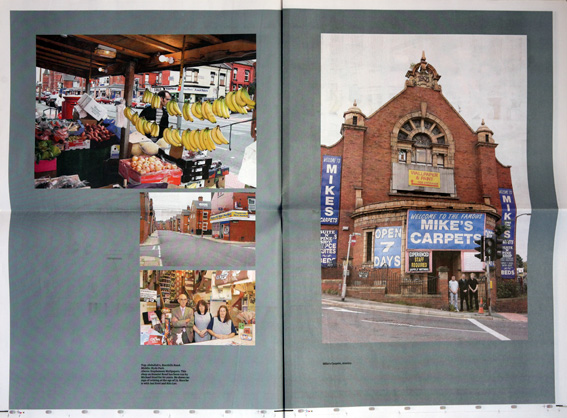
“Many people have criticised my portraits as they did not fit into their agenda. I remind people that when one is a photographer, you have the right to have an agenda, and thank God that is the case. Without them any documentary work becomes very tedious. Why would I expect this to overlap with mine?â€
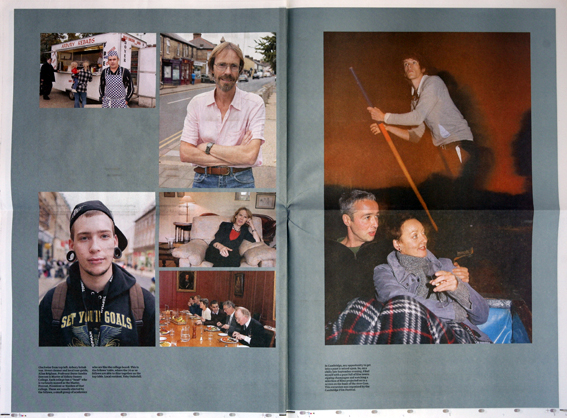
“I had no agenda apart from looking round, finding photogenic situations and I believe that I am entitled to shoot what i like.”
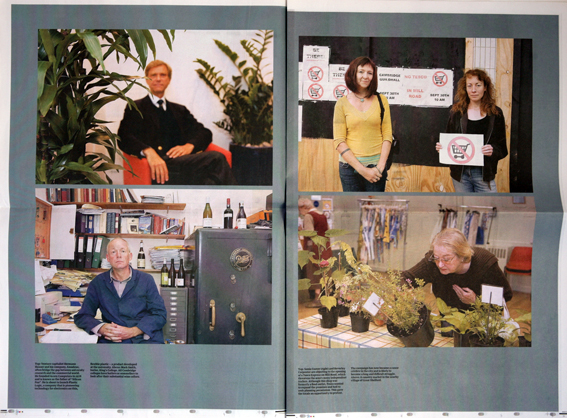
“My palette and my work is changing and shifting constantly. It would be too easy to repeat the language that I used in the 1980s in The Last Resort. Now I’m shooting predominantly digital, so it immediately gives me a different palette. Whereas in the past I shot on highly saturated amateur film emulsions, as part of the language I’d built up, now I shoot on a Canon EOS 5D with a ring flash, although the thing I really swear by is my Gary Fong diffuser.â€
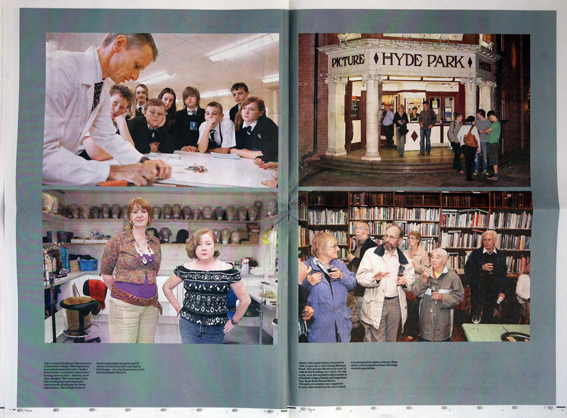
David Land sums up his interview in the RPS Journal: “You might not immediately recognize Parr’s recent work as being shot by him. Over the years, he’s built a strong characteristic style, involving bright, garish colour and people capture unawares, often in surreal or humorous situations. His latest work however, is contemplative, consensual, subdued, and quite beautiful.â€
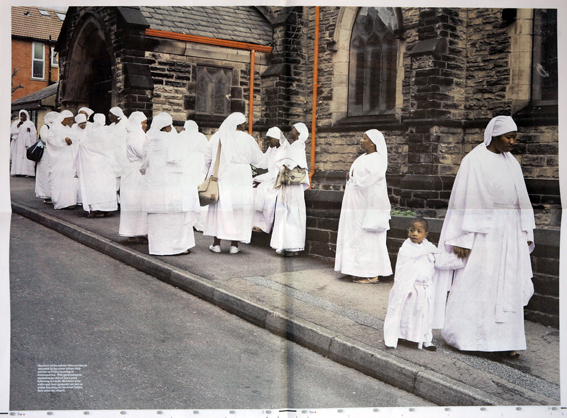
I’m not sure I totally agree with David, however, as with most of Martin’s work, it certainly has caused plenty of debate. Which I can’t fault.
Posted in OTHER STUDIES | Comments Off on PARR REPLIES
November 28th, 2008 admin
“I know of no other presentation of a particular place and people which is a broad and as captivating as James Ravilious’s photographs of North Devon. They are the fruit of a quite exceptional acuity and patience of witness and of a quite unusual humility and warmth of spirit. This great body of work establishes its author as a master of the art of photography whilst at the same time it makes an unparalleled pictorial contribution to social history.” Olive Cook, Matrix

Stephen Squire, hedger, taking a tea-break, Langham, Dolton, England, 1980
Jeremy Sutton-Hibbert has just alerted me to the work of photographer James Ravilious. James amassed a huge archive of images depicting rural England and rarely photographed more than 10 miles from his home. In 1997 he was given Honorary Membership of the Royal Photographic Society in recognition of his contribution to photography. He died of lymphoma in 1999.
Here is a biography for James taken from his website-
“James Ravilious was born at Eastbourne, England, the second son of Eric Ravilious, the war artist, wood-engraver and designer. James studied art at St Martin’s School of Art, London, and then taught painting and drawing in London for some years. He married Robin Ravilious (daughter of the glass-engraver Laurence Whistler) in 1970, and in 1972 they moved to Devon to live in a cottage near her family home in Dolton. They had two children: Ben and Ella.
In the early 1970’s James took up photography (self-taught), having seen its potential in the work of the great French photographer Henri Cartier-Bresson. Now John Lane, director of the arts centre in the neighbouring village of Beaford, invited James to contribute some work to the newly set up Beaford Archive, intended as a photographic record of life in a largely unspoilt, but vulnerable, country area. What started as a short-term project grew into a seventeen year obsession. In that time James took over 80,000 black and white images of all aspects of local life: landscape, farming, everyday life in the local towns and villages, and their special occasions. He also borrowed and copied over 5,000 early photographs of the same area.
The resulting historical span, and detail, he gave to the Archive makes it probably the most intensive record of any rural area in England. But it is more than that. Though never posed, James’s pictures are composed with the eye of an artist, and they capture subtle qualities of light – the result of years of experiment with pre-war Leica cameras and uncoated lenses. Above all, they are warmed by his affection and admiration for the people whose lives he recorded. His pictures reveal real life as it was being lived in late 20th century rural England when the country traditions that have been handed down for hundreds, if not thousands, of years were still part of everyday existence.”
You can find a selection of his photographs here.
Posted in OTHER STUDIES | 1 Comment »
Photographer Owen Richards has just emailed me and suggested I take a look at this film by Christopher Petit.
RADIO ON (1979) is described as a post-punk journey through 70s England. It’s become a cult film since its initial release and some claim it’s one of the most striking feature debuts in British cinema. Co-produced by Wim Wenders and featuring Sting’s first film performance, RADIO ON is austere in narrative and captures the lurking disenchantment of the British youth movements of the time.
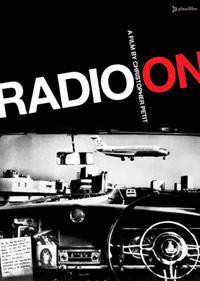
RADIO ON was photographed in monochrome by Martin Schaefer (Wenders’ cinematographer), and its soundtrack featured tracks by Bowie, Kraftwerk, Lene Lovich, Ian Dury and Wreckless Eric. Petit’s anti-road movie follows a London DJ (David Bearnes) as he travels to Bristol to investigate the mysterious death of his brother, and offers a unique, compelling and even mythic vision of a late 1970s England.
It’s been described as “a subtle, masterfully understated meditation on late 1970s Britain. Its loose, barely-existent narrative is told through a rich monochrome print of ghostly whites and glossy blacks: presenting fractured, dehumanising Ballardian urban backdrops alongside gloomy, ethereal rural landscapes. Resonating panning shots of cityscapes, saturated with the detritus of defunct nineteenth century industry, alongside boarded-up, dilapidated buildings, abandoned petrol stations and empty hotels all contribute to a profound and poignant sense of simultaneous wonder and dread. Beautifully crafted static shots emphasise the empty meaning of modern existence through images of blank, static television screens, monotonous flickering marquees and lurching fuel-pump dials.”
You can watch a trailer here.
I’m going to add it to my viewing list!
Posted in MISCELLANEOUS, OTHER STUDIES | Comments Off on RADIO ON
I must say that I’ve been totally underwhelmed by Martin Parr’s much heralded photographic portrayal of ten British cities, which have been running as ‘special’ supplements in the Guardian newspaper over the past few months.
This weekend, the Guardian’s Weekend magazine ran a cover story with a twelve page spread showing a selection of Parr’s photographs under the title ‘Urban Splash- Martin Parr captures the essence of Britain’s cities’.
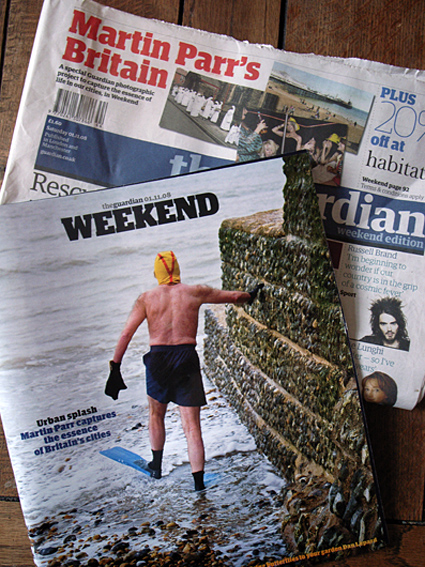
I’ve not seen the full set of photographs, however, if the magazine’s edit is anything to go by then they appear to be little more than an incoherent selection of snapshots hurridely collated, and furnished with uninteresting and often irrelevant captions. Aesthetically they seem very lazy indeed. Maybe he’s been too busy this year peddling Parrworld? (the largest exhibition to date of his work, which opened at the Haus der Kunst in Munich and is touring the world).
The whole project also appears to be very calculating in terms of its spin-offs, with various box sets (standard and deluxe) and calendars available from the Guardian website here.
I’m not one of those anti-Parr photographers, indeed I’ve long respected him as a practitioner and commentator, however it does seem that he’s missed a real opportunity to produce something interesting and illuminating about Britain, twenty years after the publication of his groundbreaking book, The Last Resort.
Much of his portrayal has certainly been seen as very stereotypical, as illustrated by these comments posted on the Guardian letters page –
“I was dismayed and shocked by Martin Parr’s supplement on Newcastle (British cities: Newcastle, October 27). He introduces his piece: “I first visited Newcastle in the mid-70s and I remember being impressed with Byker, a classic working-class suburb with a tight sense of community and steep terraces. I revisited Byker for this project and found the small shops were struggling, despite Aldi and the Gala Bingo doing well.” This shows he came to Newcastle with the notion of finding that quaint, parochial, grim-up-north picture of the Geordie struggle for survival – a dangerous stereotype to uphold.
Newcastle is no longer a bastion of British industrial power, but a multicultural metropolis often billed the London of the north because of the regeneration that has been applied to all areas of the city. Areas such as the Quayside and Jesmond have welcomed this regeneration, and have seen new life breathed into them, attracting young professionals and students alike.
There are many things Parr could have shot to highlight the urban evolution that is happening within this city. He mentions Grey Street and the stunning architecture of the city centre, but does not show it in any of his photographs. Then there are some of the many attractions that bring people to the city that he missed out in favour of outdated sentiments, such as the Laing Art Gallery, the Tyneside cinema, Blackfriars dining hall, the Tynemouth Priory and Castle, the Jazz Cafe, both universities and any one of the many bridges spanning the Tyne – I could go on.”
Nelson Iley, Newcastle upon Tyne
“Martin Parr’s supplement on Newcastle was billed as one of a series “capturing today’s urban Britain”. What he has actually done is lazily capture all the cliches of Newcastle from 30 years ago. In his 29 photographs, he manages to pack in bingo, greyhound racing, homing pigeons, a double dose of the derelict Swan Hunter shipyard, a greasy spoon cafe, two shots of hen nights, two lots of women with cheap drinks at the races, and a tattooed man prodding his barbecue. While all of the above go to make up some of the rich mixture of life in Newcastle, where are the other sides to the city? Where’s the chic city centre pubs and bars? Where are the 50,000 students? Where are the arts venues? Where is the growing multicultural community? Guess they would not suit the stereotypes Parr set out to portray.”
Graeme King, Newcastle upon Tyne
“Martin Parr seems to have arrived in Newcastle with all his stereotypes in tow, and to have regurgitated them for us with stock images of pigeon fanciers etc. Geographically, the photo essay was inaccurate. It was entitled Newcastle, but included Gateshead and North Tyneside – two areas distinct from Newcastle in the eyes of north easterners.”
Alison Grant and Anna Vaernes, Newcastle upon Tyne
You can see a selection of Parr’s images from the project on the Guardian’s website here.
I’d be interested to hear your comments on the work, if you haven’t already done so on the Flickr group Martin Parr We Love You!
Posted in OTHER STUDIES, REPRESENTATION | 19 Comments »
“To view the landscape as a pictorial composition of elements is simplistic. To perceive the landscape within a set of rules (art, science, politics, religion, community, business, industry, sport and leisure) is a way people can deal with the complexity of meanings that are presented in our environment. We are collectively responsible for shaping the landscape we occupy and in turn the landscape shapes us whether we are aware of it or not.” John Davies
One of the most impressive books published in the last decade by a British photographer looking at Britain is by the celebrated landscape photographer John Davies. The British Landscape (published: Chris Boot Ltd, 2006) features 60 of Davies’ landscape photographs of Britain, made between 1979 and 2005, presented in the order in which they were taken on a large scale with excellent printing reproduction.
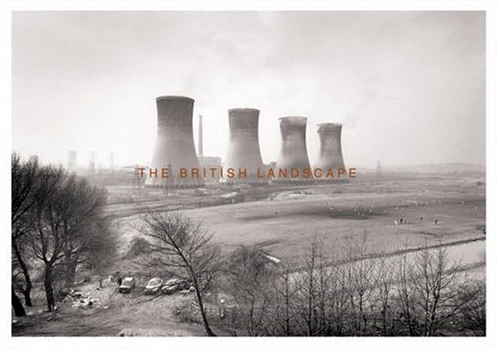
I was reminded of Davies’ book while wandering the labyrinth of paths around the North Allotment in Easington Colliery trying to track down Billy Marr’s pigeon lofts. It was here that Davies took one of his celebrated photographs ‘Allotments, Easington Colliery, County Durham’ over twenty years ago. The photograph (reproduced below) shows one of the footpaths through the allotments with a series of old wooden doors used as fences, while in the distance are hundreds of terraced ‘colliery houses’ under a signature moody sky. The photograph is reproduced in his book and was originally taken for an exhibition commission called Durham Coalfield, which was first shown at Side Gallery in Newcastle, 1983.
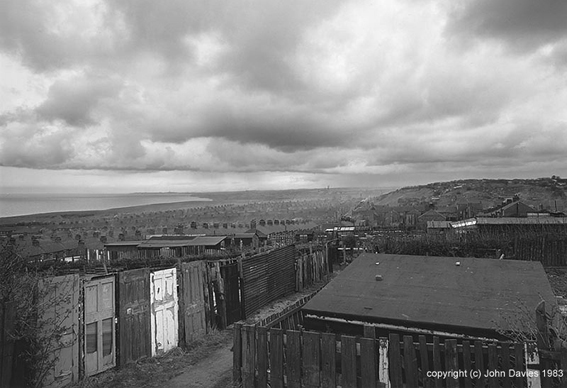
Allotments, Easington Colliery, County Durham © John Davies, 1983
Easington Colliery began when the pit was sunk in 1899, near the coast. Thousands of workers came to the area from all parts of Britain and with the new community came new shops, pubs, clubs, and rows of terraced colliery houses for the mine workers and their families. The town is known for a mining accident which occurred, on 29 May 1951 when an explosion in the mine resulted in the deaths of 83 men.
The Durham Coalfield exhibition focused on one industry’s effect on the landscape – coal production. Davies concentrated on the comparatively few places in the area (about 70 pits were closed during the 1960s) that were still producing coal – mainly 13 working collieries, the major opencast mines, and to a lesser extent the drift mines and sea-coal gatherers. His photographs, with their combination of general view and finely noted detail, make powerful and visually sensitive documents of the effect on the Durham landscape of two centuries of coal mining.
The allotments had changed little since Davies’ photograph was taken, with the old wooden doors still standing proud. However, the town has changed significantly with the closure of the mine in 1993 and the loss of 1,400 jobs. This caused a massive decline in the local economy; Easington Colliery is currently the 4th most economically deprived place in England.
You can see all his photographs from the commission here.
With reference to We English and my interest in leisure, here are two more of Davies’ photographs, including the iconic image ‘Agecroft Power Station, England, 1982’ which features on the cover of The British Landscape:
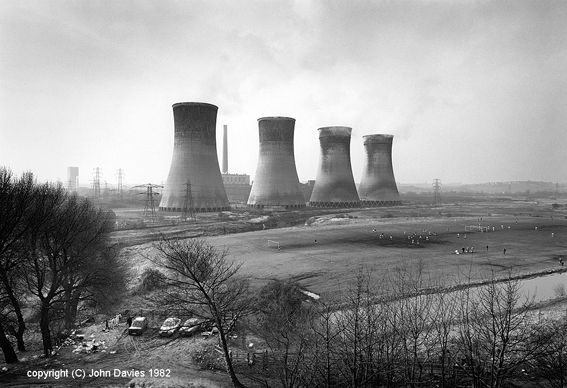
and ‘Bowling Greens, Stockport, England, 1988’:
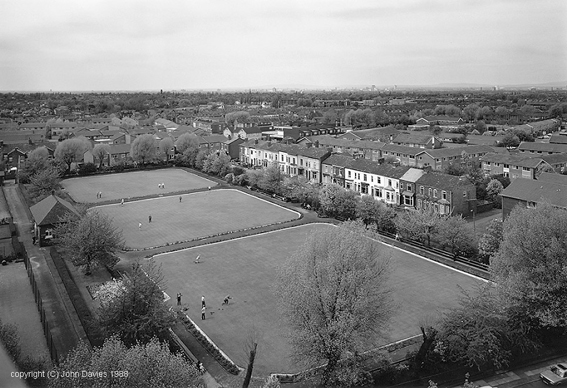
You can read a review of The British Landscape on the blog Photography & Books here.
You can see more of John Davies work on his website here.
Davies’ is represented by Michael Hoppen Gallery in London, and you can read his biography here.
Posted in OTHER STUDIES, PLACES | Comments Off on JOHN DAVIES & EASINGTON COLLIERY
After writing my The Turner Effect blog entry I was reminded of John Taylor’s book A Dream of England. In the book Taylor talks about how the tourist industry uses heritage and draws on poets and novelists to advertise places – Shakespeare Country around Stratford-Upon-Avon (also branded England’s England), Bronte Country in Yorkshire, Hardy Country in Wiltshire and Dorset, Catherine Cookson Country in Tynesdie and Beatrix Potter tourism in the Lake District.

In a chapter titled ‘Pleasures of the Imagination’ Taylor looks at the work of photographers who have adopted a “quizzical stance in relation to the kinds of photographs which tourists produce or which are produced for them in guidebooks.†Photographers who “express doubts about the imagine community of England fashioned in the image of the dominant white middle class.†Taylor terms these individuals, ‘oppositional photographers’, and he includes bodies of work by Martin Parr (Cost of Living), John Kippin (ENGLISHISTORY), Karen Knorr (Monks of Disfunction), Ingrid Pollard (Pastoral Interludes) and Paul Reas (Flogging a Dead Horse).

© Paul Reas
In Flogging A Dead Horse, Paul Reas photographs the tour guide who carries a reproduction of Constable’s original Flatford Mill painting and is seen indicating the area which Constable actually painted, thereby overcoming the tourists fear of failing to see the desired spot. Reas’ work is a biting criticism of the heritage industry, an industry which Taylor suggests “represents a break with a politicsed and complex historical appreciation of contemporary English life.†Heavyweights such as English Heritage and National Trust use entertainment to display history, but a sanitized version which is just a representation of the past, clinical and doesn’t present contradictions or context.
You can see more of Reas’ work from Flogging a Dead Horse (Pub: Cornerhouse/Arts Council, UK 1993) here.
Posted in OTHER STUDIES, RESEARCH | Comments Off on HERITAGE INDUSTRY
















































